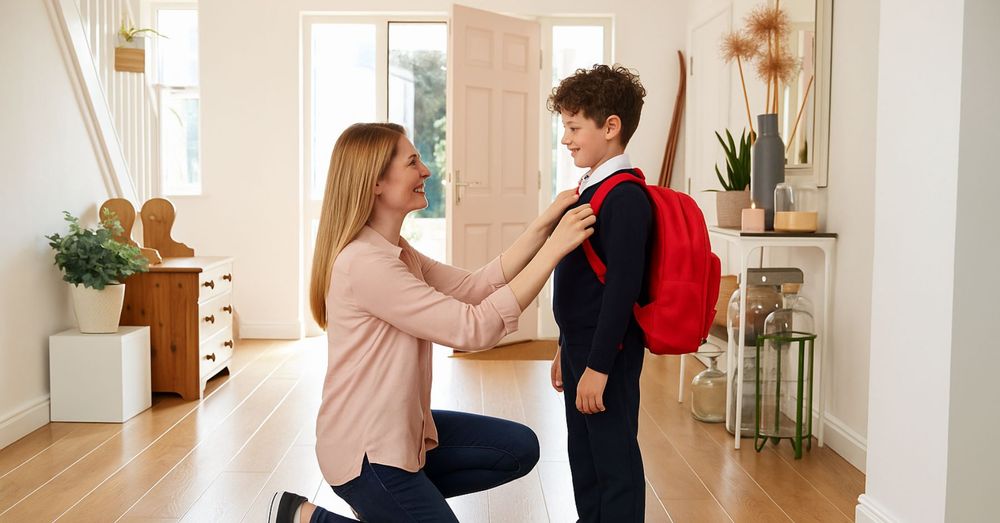SCREEN TIME
9 Tips to Reset Screen Time for Back to School
Back to school isn't just about new supplies and fresh schedules. It's also the moment to look at digital habits again. Over summer, most kids enjoy more freedom with screens. But as school routines return, it helps to set clear expectations so homework, sleep, and balance don't get lost behind a screen.

Why Routines Matter
The shift from holidays to school is quick. One week kids are staying up late, the next they're expected to wake early and concentrate in class. If screen habits stay in "summer mode," mornings drag, homework stretches out, and sleep takes the hit.
Children handle change best when daily life feels steady. Simple rhythms - homework before play, screens off before bed, devices put away at night - give kids a sense of structure. That stability makes it easier to adjust and keeps energy for the things that really matter.
The start of a school year is the perfect time to reset. Here are nine ways to bring screen time back into balance.
1. Reset Boundaries
One conversation at the start of term isn't enough. Keep checking in about what your kid is doing online, what's working, and what might need adjusting. Boundaries shift as kids grow, and Ohana makes it easy to update them.
It's also worth talking about new tools, especially AI. Maybe it's fine for brainstorming or practising vocabulary, but not for writing essays. And if your kid isn't ready yet, Ohana's Advanced Blocking can block specific AI chatbots.
Tip: Use our Tech Agreement as a starting point (or revisit the one you already made). Writing down the rules helps everyone remember what was agreed.
2. Focus On Schoolwork Before Free Time
Homework and phones rarely mix. Messages and games steal focus fast. A simple rule - schoolwork first, screens later - shows kids that responsibilities come first, while fun still has its place afterwards.
Ohana's Study Mode can pause distracting apps until homework is done. It also works during school hours: parents choose which apps are allowed, while calls are always available in case of emergencies.
3. Set a Digital Curfew for Bedtime
Screens are one of the biggest sleep disruptors. The light from phones and tablets delays the body's sleep signal, making it harder for kids to settle. Setting a "no screens" window at least an hour before bedtime gives them space to unwind.
With Ohana's Bedtime Schedule, apps lock automatically at night so kids can switch off more easily. Still, it helps to keep devices out of bedrooms altogether. Charging them in the kitchen or hallway removes the temptation to check "just one more thing" late at night or grab the phone first thing in the morning.
4. Put Educational Apps Front and Center
What kids see when they unlock their phone matters. Keep calculators, dictionaries, and homework platforms on the first screen. Move games and social apps into folders or onto later pages. A quick reshuffle makes useful tools easier to reach and temptations less visible.
5. Turn Screen Time Into Learning Time
Not all screen time is wasted time. A language app, flashcards, or a creative tool can turn minutes online into something valuable. Even swapping ten minutes of scrolling for ten minutes of purposeful use makes a difference over time. Ohana's Smart App Check shows at a glance which apps support learning and which only drain attention.
6. Stay Connected on the Way to School
If your kid is starting to walk to school alone, it's a big step for both of you. With Ohana's Geofences you'll get an alert when your kid arrives at or leaves a chosen place, like school or home.
Your kid gets notified too, so they can be reassured that you know where they are. It's a simple way to give them independence while keeping both sides connected.
7. Get to Know School Tech
From homework portals to class chat groups, schools now rely on digital tools. If your kid has a school-issued device, take time to see what's installed, what's allowed, and what settings you can manage. Knowing the basics makes it easier to support their learning and spot problems early.
And when you're familiar with the apps your kid genuinely needs for school, it's harder for "I need my phone for homework" to become an excuse for sneaking in extra screen time.
8. Weekends Can Bend, Not Break
Rules that are too rigid often backfire. It's like strict dieting: if it feels impossible, kids will push back harder. A little flexibility makes routines easier to stick with.
Friday and Saturday can be more relaxed with some extra screen time, but keeping Sunday evenings calmer helps Monday start smoothly. Limits work best when kids see there's space for both rules and exceptions.
9. Model the Behavior
We highlight this often because it really is that important: kids copy what they see more than what they hear. If parents scroll during dinner or keep phones on the nightstand, kids learn that's acceptable. Setting your own limits - phones aside at meals, devices charging outside bedrooms - makes balance a shared practice, not just a rule for kids.
Back-to-school always feels like a shift, but it's also a chance. Clear routines and steady habits make kids feel secure - and make daily life smoother for everyone. You don't need perfection; what matters is consistency. With your guidance, kids will find their rhythm again faster than you think.